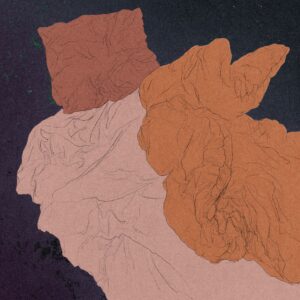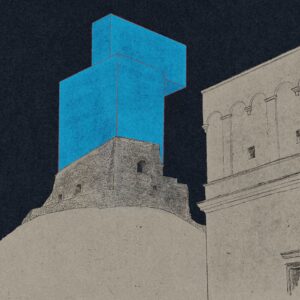Remembering so as to Forget
‘Sometimes, a complete state of helplessness overwhelms me. You think that you’re a part of this world and that helplessness is so horrible and cynical. You stop and ask yourself: How is it that the universe is black? Why does this terrible darkness envelop us? We are here, enlightening ourselves, living comfortably, but that existential question of why all of this is happening doesn’t go away. When I’m working I can fall into such a state of horror – and then you think that it’s better to turn on the lights and live in some semi-illusion so that you can actually do something. Of course, you have to make an effort, you have to think. As I created my series there was this childish enthusiasm: I’ll study something, I’ll find the answers to my questions, and then it will all become clear to me. Because I’ll delve into a subject, I’ll start doling out propositions about what is good and what is evil. And when I started to go deeper, I understood that the clarity I had before was clearer, and that my uncertainty had only increased. And because of that, I became less categorical.’
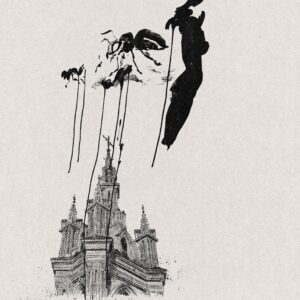
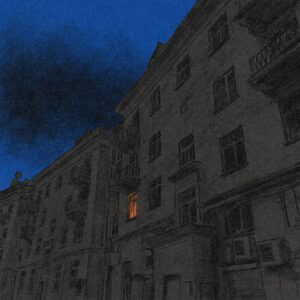
These are the thoughts shared with me by Mindaugas Lukošaitis at our first meeting in a hall in the small town of Vandžiogala, where Mindaugas was presenting a series of drawings he was working on at the time titled Gyvenimai. Vandžiogala (Lives. Vandžiogala). I had asked him whether he felt that he was doing everything he could to stop the things he was drawing from happening. In Rezistencija (Resistance), Žydai. Mano istorija (Jews. My Story), Ruanda (Rwanda) – Lukošaitis’ imagination reconstructs versions of tragic events in Lithuania, Europe, and Africa and recreates traumatic moments of historical reality.
It seems to me that Lukošaitis knows what lies in the darkness, better than he’d like to believe. He is able to grasp the deepest nerves, and his uncluttered yet detailed visual expression of the horror of those events can be felt by those who have not experienced such events, or who have experienced something similar, in a different time or in a different corner of the planet. Mindaugas created the Resistance series asLithuania was joining the EU and NATO, but it did not achieve the recognition it deserved in the artist’s home country. Yet the same series was met with acclaim at the 2004 Bienal de São Paulo and the works were subsequently acquired by the Louisiana Museum of Modern Art in Denmark and exhibited together with Picasso and other world-class artists.
Over telephone in March 2023, we discuss a recent visit Lukošaitis had made to the Ninth Fort Museum in Kaunas. ‘They want to mount an exhibition on the 1943 escape of prisoners who didn’t want to be corpse burners. Over sixty people escaped the fort then,’ Mindaugas says, as he prepares to draw another uncomfortable scene. He also mentions that he’s immersed in his doctoral studies.
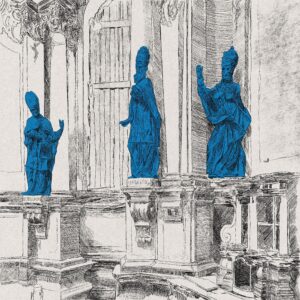
What is your doctoral research subject?
About drawing before drawing; about the processes a person has to go through – what to do, how to think so that a drawing is successful. It would seem this is based on academic drawing, which I am most critical of, and on shared human experiences. For example, how do choreographers make a drawing? What about actors? How do they prepare for a role, how do they fine tune a character or a situation? I don’t look at drawing as a formal process, as contouring, but as a set of experiences, knowledge, and techniques, leading to a goal. Studies are a chance to reconsider yourself, to revise what you’ve done, and to articulate it. And though I try not to talk about my historical subjects during the process, the people around me keep coming back to them and asking questions. I stress that this is just a result, a later stage; and that what comes before it is more important to me in my work.
But that’s the most interesting thing of all – what leads up to the drawing itself.
I found that, when I was a student, I hadn’t heard about experiences about how to draw, how to create in the general sense, how to arrive at it – these subjects were left to their own devices, ‘well, you’re figure it out somehow.’ But skills and abilities are based on self-understanding – what you want to say and the things needed to reach that goal have to be understandable to you. From that lack of understanding comes a kind of artistic excess – when the creator themself doesn’t understand what they are doing. I wouldn’t want to be considered that way, but it does happen.
Mindaugas, what were your first drawings about, when you still didn’t know anything yet?
When I’d talk about particular events with people close to me, they’d be surprised: You can’t remember that, you were too small. But I do remember. I started drawing early – making doodles, so to speak. Back then, that was the ultimate pastime. I remember that when I paged through my early drawings, I noticed from the start that I wasn’t doing contour drawings, like a tree or house from the side, but I would rotate the objects three-quarters of the way – there was this spatial experimentation happening. My father, may he rest in peace, was a sculptor, so the house was full of felt-tip pens and other tools. Now people toss phones to their children to keep them busy, but then they would give you some cardboard and a marker. There were lots of books about art at home, too. The older I get, the more I understand that what I saw in those books, even before I started attending school, perhaps had even more of an influence on me than my studies. My tastes developed in childhood. A lecturer at the Vilnius Academy of Arts once said something strange – he said, ‘I can see when a student has grown up with at least one art publication at home, and when one hasn’t.’
I remember being so drawn to what I’d seen in those books, and dreaming of reaching the same level, even though that seemed an impossible thing, but the aspiration inside of me remained, like a virus. Maybe that’s why, in the contemporary art context, I feel a bit ancient, frozen in time, with my drawings. And maybe that’s why I developed my drawing in my spare time, and I didn’t prioritise it early on in my artistic career. The realism is misleading – and it’s unnecessarily equated with Socialist Realism. But they’re not the same thing. Realism is not a genre or style. It’s an imaging strategy. But I needed to comprehend this, and I’m grateful to the teachers who encouraged me, who would ask me why I was submitting one thing to them, but doing something entirely different – something I actually liked doing – on the side? It took me a while to shift my focus, to find out that drawing was the best medium for me. Now I’m systematising the methods that I searched for and found. For example, the technique of drawing from memory – I’ve already assembled piles of sheets with the letters ‘dr’ in the corner, and I’m trying to reflect the technique of getting to the essence, to get calibrated, to direct and establish myself, and then to release the charge. The initial impression that something is depicted isn’t enough. It’s like orchestration: We listen to an entire piece, to a resonance, but it’s performed by many instruments. It’s sewn together with many threads.
My discoveries from drawing from memory became more profound when I began exploring historical subjects. That’s when I understood the need to remember. And while I myself can’t remember what I didn’t take part in, with my work I still try to give general knowledge a form that would be appropriate for this time, for contemporary emotion. When you notice that casual drawings dissonate with the chosen subject, you start looking for an approach and a consonance between the chosen method and what you want to portray. This is how a drawing evolves. And it’s been going on since I was three, until now.
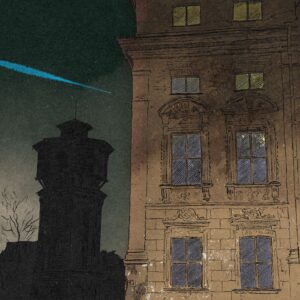
Memory is not the same thing as history, as you just noted. You’ve drawn a lot of things that happened before you were born. On the other hand, you’ve been publishing the ‘Z’ series online every day for over a year. The way I see it, it has more of your perspective, your values, even anger, than the earlier works. This series seems more personal, but I might be wrong. Is it always important for you to express a position?
I’d have to talk about professionalism at this point. Whether to approach a subject through a personal perspective or by technique is the artist’s choice. Mimicry can become part of a work, it can help put a person in a provocative state. Am I convinced by what I see, or is someone trying to deceive me? Or maybe they’re trying to create an intimate connection? All of this can be part of the strategy of your work, in this case the message – you need to choose the relationship. This happens before the drawing. When you really get into it, personalise it, it can get in the way, because you start to portray things that don’t fit the story. You start to moralise, to engage in didactics. This is good, that is evil…
Historians say the problems arise when someone with a contemporary experience goes into the past and tries to apply progressive standards there. At one time, I was really interested in sociology, and what really stuck me was that someone who studies human relationships and phenomena has to be indifferent; they can’t have any sympathies for politics or an orientation. It’s the same thing here: When you enter into a subject, you can become tendentious and cherry-pick, and stress things of secondary importance. It’s important not to lose restraint. But, of course, you can’t completely avoid a personal connection! If I were indifferent to a subject, I don’t know what pragmatic calculation could encourage me to work. After all, I took it on, which means I care about it. But I set a goal for myself as an artist: not to show others that I’m engaging in my own therapy, that my own psychology is what’s important to me here. When I encounter self-therapising in other works, I start to think: Ah, these are their problems, but no longer ours. Sometimes a distance in time helps in this regard. There are subjects that I’m setting aside for the future. I know I have to do them, but I can’t find the key. I feel there are too many emotions stirring.
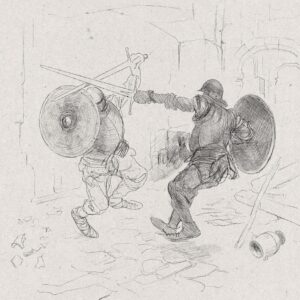
From what I’ve seen in new works by Ukrainian artists, the self-therapy we are talking about is not always concealed, and that can be very appropriate, powerful, beautiful, and necessary. And if not in the piece itself, then in the caption accompanying it – where an artist pours out how they felt that day. What do you think about that?
Well, there’s something important to consider here: Whether the bearer of memory is a witness to an event, or the witness of a testimonial. Whoever experiences something brings something out of that situation – that initial, authentic feeling – that a witness twice, or three or four times removed cannot grasp. Of course, the first witness has it the hardest and experiences the most dramatic impact. They have to consider the audience they’re speaking to. I and anyone else, who have some distance, can view the reception with more sensitivity. Living, painful memories are like deep cuts – they’re harsh. It’s no coincidence that the testimonials of ghetto prisoners consist of just a few powerful outlines, a few words. You may want to build tension, to mimic that clarity of speech and line, but that’s not possible.
You said you have subjects where you feel too much emotion. Does that mean you don’t want to become that first eye witness?
Maybe it’s all a problem of a lack of time. If the subject is narrower, it is easier to work with, and that word ‘life’ – it can contain an awful lot. I have one such subject ‘about everything’, but I’m still looking for an approach through it all. It’s like preparing for an expedition, which if you fail to prepare properly for will be obvious. Why deceive yourself and others?
As you create your series about Lithuanian Jews, the genocide in Rwanda, the Lithuanian partisans, and even the city of Vilnius itself, do you think about viewers who may have been part of those events themselves, or who may be the descendents of those that were?
I thought about this the most as I was creating Jews. My Story. It was the most sensitive subject, and caused the most waves. I carried it with me from childhood, from the forest and the graves within them. People spoke about it in different ways – whether in a simple, domestic way, or casually or antisemitically. There is no single answer, but we may want one – how? What is this? What happened here? I set it aside several times and told myself I wouldn’t do that piece. When I began to draw I realised that, with those drawings, I wiould be resurrecting such suppressed, blocked images… The question became whether it was worth awakening the memory – destroying, digging into it – or perhaps better to wait until everything was forgotten. But because I always have a pencil and paper nearby, I came back to it. It became interesting that some of the images and etudes I chose, were not direct – quite the opposite, they were purifying. Now, with the war in Ukraine, we have a lot of grease, blood, and smoke – materials that are close to us and, because we are animals, too, they signal self-preservation, calling us to close ourselves up, not to see or hear anything anymore. This is no longer there in the drawings, only flashes of images that sensitise the viewer’s imagination.
When I observe the events in Ukraine, and as I look at the photographs and filmed images, I turn on my ‘researcher perspective’. I’m allowed to be a researcher – I’m doing my PhD (smiles). I study an explosion – so much material there! Frozen metal – like a waterspout. There’s a tank standing in Vilnius now, you can go see it. You look at that spout of water and think – My God, such fluidity, such lightness. What insane force peeled it back so much that the metal looks like silk? For me, that kind of study is an outlet for drawing. I look at rags as I would drapery, and I remember art history again, the rhythm of folds, into which a story is woven. Meanings are conveyed not anatomically, not directly, but through materiality, leaving room for a person to get hooked and plunge into their own personal imagining, to manoeuvre within it. When I was creating Jews. My Story, I hadn’t yet identified that kind of approach as a strategy; it scared me, I didn’t understand what a drawing could do. It’s horrible not to control that possibility and later deal with the consequences.
You mentioned the responsibility felt before releasing a work into the public. I recently read Linas Venclauskas’ book Tekstų byla. Lietuvių antisemitinis diskursas nuo XIX a. antros pusės iki 1940 metų (The Case of the Texts: The Lithuanian Anti-semitic Discourse from the Second Half of the nineteenth century to 1940). Although there is a long history of propaganda techniques, it’s harrowing to realise how articles and messages in the press are used to shape a point of view that incites hatred and mass killings, and to see the power of a word or image or – in the case I have in mind – a caricature. Do you think about the effect your drawings have? Does this determine whether you publish them?
I might revisit the ‘drawing before the drawing’ here. After I began studying the technique of drawing more consciously, I understood that the manner, tempo, and rhythm of a drawing – the mood, and your own disposition, to put it more plainly – can settle in between the lines and program entirely different things than what you are formally representing. I’m not just talking about symbols that researchers study, I mean the entire overall temperament and the influence it creates. And so, only after studying it, did I understand that, in my own drawings, one thing is portrayed, but something else is seen. I used to think that professionalism was just a pose, an image, very often a useless one. But when you encounter the excitement of what someone will see, then professionalism takes on a different meaning. A true professional is responsible for that, of course.
It’s interesting to search for this in other people’s work, as well as in film – what it is that stands out. I haven’t made any new discovery, because sometimes just from talking to a person that’s telling a serious story, it’s their body language, smile, gaze, everything about them that reveals what was going on rather than the words themselves. That’s the interesting and dangerous part of it all, and also in works of art, when one thing is said, but something different is felt. In general, body language is very interesting to me, and I study it because I don’t hear well. Only by looking at the whole can you understand whether the person himself understands what they’re doing, drawing, speaking, or showing, or whether their attitude and subject matter come together into one whole, or whether they’re just imitating it.
However, attempts to look for an author’s psychology, his or her life traumas, in their work of art can end quite humorously. My own work contains a great deal of mechanical calculation, you won’t find any autobiography there; I do it because it has to be done one way, and not the other.
There can be a lot of politics in the impact of a work. For me, it’s more interesting not to get political, and better to look at it as historical material that simply exists, to build a relationship with the facts and shed light on certain aspects. There are many reinterpreted works in art history, and that’s all fine, but if you want to erase or expel something, or to give it some special status, I immediately wonder if that’s not a momentary thing more than a professional reflection. Even when we talk about monuments – at what point is a monument propaganda, and when is it just a grave marker? We need a stronger voice from the historians, a more careful scrutiny. I’ve come across a lot of politically motivated texts in this field, and that should not be the case.
But it’s very a human thing to tug the blanket to your own side, especially if it has to do with your own country, city, or family, which particularly undermines the foundations of professionalism for both scholars and artists alike – after all, that’s what this entire magazine is essentially about, the memory wars.
Absolutely. That’s’ why, when they say that a historian is a scientist, I want to shout back: more like an artist! Or, in that case, then an artist is a scientist! What I mean is their approach to and perspective on a subject. A personal perspective will always be felt from the side, especially if that side is the opposite one. But I very much miss discussions. After all, when there is disagreement over something in the past, we must remember, and then you can put that something into a drawer and move on – in other words, forget it. But how to remember, how to give form to memory, and not necessarily a static one? The role of museums is vital here, as well as such programs as the Memory Office undertaken in Kaunas that create situations where a subject comes back to life.
Do we need to forget to make room for the present and the future?
I believe so. Otherwise, if we don’t put things away, the present begins to compete with history. Especially during the war in Ukraine I’ve noticed that, for me, a past reflected upon has become the present. Time would appear to be linear, and we are in a new section of it, with old events somewhere behind us. But no, as things have intensified, I entered a spherical state – these events are here and now. The tide of the Second World War has risen again, and this is truly the inertia of an unfinished war. Like those old land mines still lurking in the ground, that overcome time. Those old mines, and the ones being laid around Ukraine today – they’re one and the same to me.
I learned yesterday that Bulgaria, unbeknownst to some of its pro-Russian government ministers, transferred Soviet-era weapons worth one billion euro to Ukraine. It’s terrible to say this, but this affair has fascinated me, and this is about that same sphere.
Yes, it’s interesting how it’s possible to turn history around against oneself. The current war really does capture all of the tensions and incapacity of memory. This tension-filled time cuts through one’s identity. There are no more grey zones, you can’t manoeuvre anymore – everything has become sharp and contrasted, illuminated in such a way that we can now see the tail and hooves that were once concealed in the twilight. If you don’t say “yes” or “no”, if you don’t pick a side – you’re pummelled with accusations. Identity – whether for an individual or a community, for a nation – is a complex construct, after all. Perhaps your parents or relatives fought on one side, and now you have to perceive yourself anew. Perhaps even more horrible than death itself is the death of identity.
Now, as you create the Z series, you reflect on an ongoing story that is not yet history. Why?
I understood that I didn’t need the distance of time. It’s interesting for me to observe the mechanism – how the imagination expresses itself in the current war, because it is also a war of the imagination. As I draw the stories, I study how propaganda works, I observe which images people react to. It may sound horrible, but this is laboratory work – from materiality to human relationships, exploring everything now seems meaningful to me.
